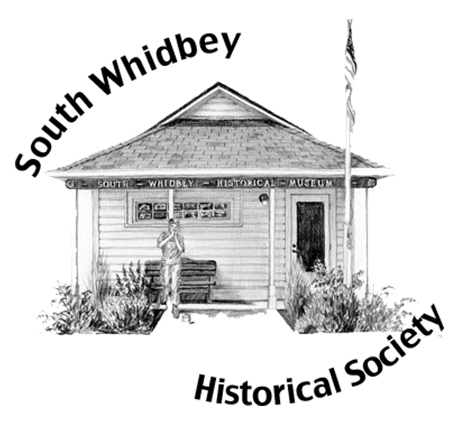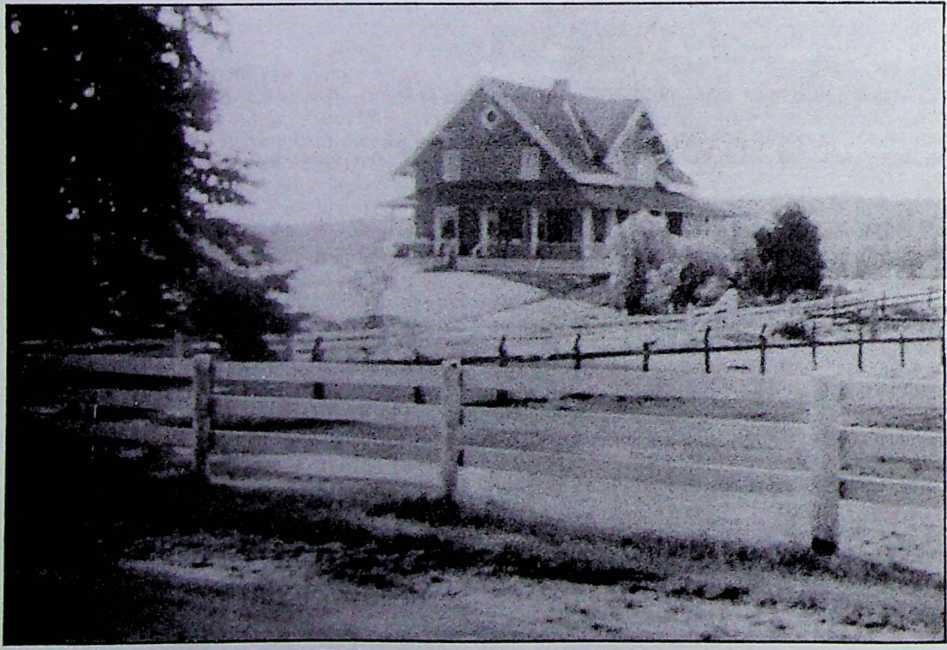
Mrs. Craw’s Sunday School class, Woodland School, July, 1909. Back row left to right: Marie Kyllonen, Hilma Tulin, Linda Kyllonen, Pearl (?), Enid Feek, and Eda Tulin. Second row: Martha Blanes, Beula (?), Mrs. Craw, Evelyn on lap. In front: Hallie Niemi.
The cat was soft and cuddly and used to sitting on people’s laps, purring away. On this particular day, it was sitting on its mistress’ lap, but it wasn’t purring. It was hissing and clawing to get away. Evaline Boyd Craw was attractive and intelligent, and was used to presiding over her home and family, including the cat, with skill and grace. On this day, she was neither skillful nor graceful as she attempted to control the scratching, hissing cat and to soothe her two sea-sick children—all the while trying to settle the butterflies in her own stomach as the gasoline launch in which they all were riding from Everett to Clinton roared its way across waves which seemed to her to be deliberately attacking the boat with intent to destroy. The reason that she, her daughter Ada Marie, her son Sylvester, and the cat were in the boat was because her husband, Alvan Herman Craw had sold their dairy farm in Wichita, Kansas in 1906, and purchased a quarter section of virgin forest land on South Whidbey Island, including 20 acres of rich marsh land that reached eastward from Miller Lake in the interior of the Midvale area. He was now moving his family from their temporary Everett home to a house he had just completed building on his island estate, which later became known as the Craw Mansion. The boat arrived at the Clinton dock with Evaline and her two children safe, but far from intact. As for the cat, the less said, the better. It finally managed to squirm loose from its mistress and jumped overboard. Whether it had exhausted the last of its proverbial nine lives when it hit the cold waters of Saratoga Passage it is not recorded, but it was never seen again by the Craw family. Alvan Herman Craw was born in Sudorus, Illinois in 1867. His wife, Evaline Boyd, was born in Troy, Illinois, in 1870. They were married in Ridgely, Illinois. In the Craw family, there were seven children, four girls, and three boys. The first-born was Grace, followed by Cena, Earl, Edson, Sylvester, Ada Marie, and Evelyn. Alvan H. Craw had a strong desire to go West. In 1906, he set out alone from their dairy farm near Wichita, Kansas to look around, traveling by train from Kansas to Washington state. He was impressed with the enormous size of the fir, cedar, and hemlock trees on South Whidbey Island, so he made plans to purchase a quarter of a section of the virgin forest land. This parcel had 18 to 20 acres of rich marsh land and a high hill, a perfect spot on which to build a home overlooking the clear swamp that reached to Miller Lake and beyond. Alvan Craw returned to his rich productive dairy farm in Kansas and proceeded to auction off the property, farm equipment, household and personal belongings. He then bundled up his family (with six children at that time) and they took the train to Everett. Settled in Everett, Ada and Sylvester entered grade school. The oldest daughter, Grace, went to Normal School in Bellingham. Cena took a business course in Everett. The two older sons accompanied their father to South Whidbey to clear land and to provide dwellings for the family. It took a number of years to clear the land, log off timber, build roads, build a large family home, a large barn, a chicken house, and a spring house for the milk separator and all the dairy produce consisting of milk, cream, butter, cheese, and buttermilk. These were kept cool by a stream of water. The Enterprise Farm was well named. It was a big undertaking. With a team of mules, Kit and Topsy, high- spirited and eager for action, they tried to pull a heavily loaded logging wagon off the land, but found it to be impossible. Then, Mr. Craw built a small saw mill and furnished lumber to the new families who purchased the rich peat moss land in the long stretch near Miller Lake. About 1907, Mr. Craw furnished the lumber for the one-room school house on Maxwelton Road, known as the Woodland School. One of the first teachers, who taught all eight grades with an average of twenty pupils, was Grace Craw. There is testimony even today as to the fine teacher she was by those still living who had her as their first teacher. Fourth of July celebrations in Maxwelton were a big event. A crowd would gather for food, baseball, game contests, and then a campfire in the evening with group singing. Another exciting event was the annual magic and gift Hallowe’en party at the “Craw Mansion.” The ghosts, goblins, and witches were in control for a fun night. Some winters, Miller Lake froze thick enough for skating. When there was snow, Kyllonen Hill was a popular place for sledding. Work progressed on the farm. The marsh lands were drained with deep ditches. The mules, wearing heavy wooded slabs clamped onto their shoes to keep them from sinking in the wet soil, pulled farm equipment that worked the natural rich earth. This land produced an abundance of hay, grain, vegetables, fruits, and berries. The wild huckleberry made wonderful pies. Mrs. Craw made jams and canned many quarts of fruits and vegetables for the winter. She also made pickles, horseradish, tomato relish, mincemeat, and sauerkraut. At other times she canned salmon which she purchased from the Maxwelton fish traps. Many of the salmon weighed from ten to twenty pounds, and she bought them for ten cents each. All the children grew up healthy and strong, and there was little need of a doctor. “Mother Craw” was the midwife who took care of emergencies with her nursing skills and prayers, and the whole family survived. About 1912, the telephone came to the Midvale area. It was a party line and a long wooden box hung on the wall with a crank to turn for rings. The Craw’s ring was two long and three short. Mr. Craw helped build roads through the woods that later became main traveled roadways. One still remains marked Craw Road extending from Maxwelton Road to the state highway. Ada Marie Craw, now Mrs.
Theodore Kyllonen, says that the island people lived in harmony, that they were concerned with the golden rule, and put it into daily practice.

